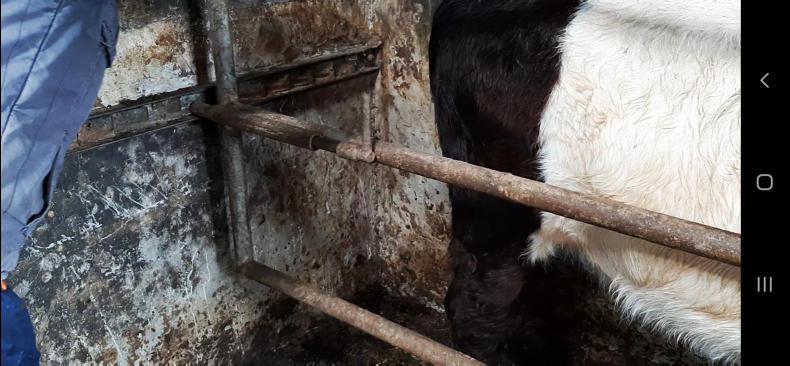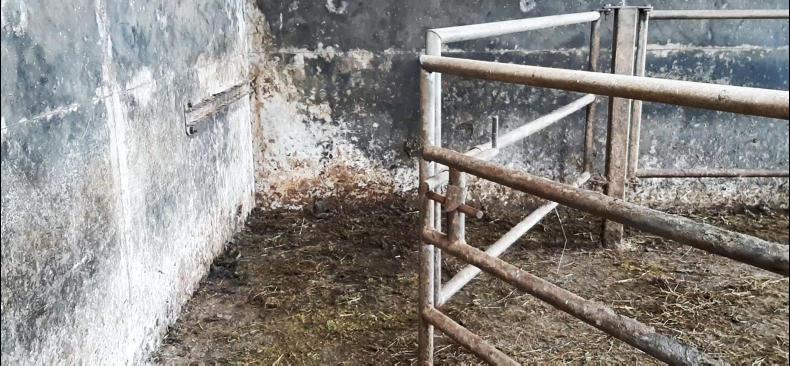When handling livestock, there should be two main aims – the system in place should allow for animals to be handled in an efficient manner, while safety should always be a priority in the design of new units.
Many suckler sheds combining a slatted area and adjoining creep or solid-floor areas have been constructed in recent years, with the inclusion of a cattle crush.
The aim of the crush is generally to allow sick animals to be handled easily, to administer minor health treatments or as an aid during calving.
Where crushes have been badly designed or space is at a premium, they can end up having the opposite effect and actually increase safety risks when working with livestock.

The gate of the creep area and the crush meet and interlock in the centre to provide a runway from the slatted shed into the crush.
Safe and efficient design
Ivan Delaney Steel Works, located in Newbridge, Co Galway, has designed and fitted a longer crush section than would generally be possible in a number of sheds, by installing a gate or section at the end of the crush that closes into the wall, which is at a right angle to one the crush runs along.
The shed featured in this case is a two-bay, back-to-back slatted shed with a creep area on one side. The design allows the crush to hold four large or five medium-sized cows and allows the slatted pen areas to double up as holding pens serving the crush.
The final section of the crush in the main photo is 2.08m (82in) and swings over 180° to lie parallel with the crush when fully open. The closing of the gate has the safety of the operator to the fore.
There is a spring-loaded latch on the gate and this closes into a 1.42m (56in) steel mechanism with 13 notches of equal length.

The spring-loaded latch easily pushes in along the closing mechanism to tighten animals into the crush and restrict movement.
Once the latch catches on the first notch, the gate is secured and animals cannot force the gate back out on to the operator.
The gate can be simply pushed in as animals move up along the crush and more space becomes available. In this regard, the mechanism is also an excellent aid for a one-person unit, where animals at the head of the crush stall near the front.

The spring loaded latch can be opened by pulling back on the handle.
The spring-loaded component on the latch will automatically secure the gate as it moves along each notch. The gate can also be closed fully to curtail movement in the crush when it is not full.
Filling the crush
The other noteworthy safety feature is that the crush can be filled from the adjoining slatted penned area. The access gate from the creep area into the slatted area is – in this case – 2.24m (88in) in length. This gate opens to meet the crush gate and the two interconnect to form a rigid runway into the crush.
Ivan says the gates were constructed at such lengths to suit the width of the creep area.

He advises that where a crush is being included in a creep or solid-floored lie-back section, to leave the area good and wide in order to have plenty of room to work.
Ivan says three to four foot extra space in this regard provides lots of additional scope, with a world of difference between a 12ft creep area with a crush and a 15ft or 16ft creep area with a crush.
The wider creep also gives more scope to install a calving gate, if required, between the two pens.
The animals exit the crush and enter the adjoining slatted area. In the shed in question, the four pens can be utilised when handling cattle, with animals moved in a circular motion.
When handling livestock, there should be two main aims – the system in place should allow for animals to be handled in an efficient manner, while safety should always be a priority in the design of new units.
Many suckler sheds combining a slatted area and adjoining creep or solid-floor areas have been constructed in recent years, with the inclusion of a cattle crush.
The aim of the crush is generally to allow sick animals to be handled easily, to administer minor health treatments or as an aid during calving.
Where crushes have been badly designed or space is at a premium, they can end up having the opposite effect and actually increase safety risks when working with livestock.

The gate of the creep area and the crush meet and interlock in the centre to provide a runway from the slatted shed into the crush.
Safe and efficient design
Ivan Delaney Steel Works, located in Newbridge, Co Galway, has designed and fitted a longer crush section than would generally be possible in a number of sheds, by installing a gate or section at the end of the crush that closes into the wall, which is at a right angle to one the crush runs along.
The shed featured in this case is a two-bay, back-to-back slatted shed with a creep area on one side. The design allows the crush to hold four large or five medium-sized cows and allows the slatted pen areas to double up as holding pens serving the crush.
The final section of the crush in the main photo is 2.08m (82in) and swings over 180° to lie parallel with the crush when fully open. The closing of the gate has the safety of the operator to the fore.
There is a spring-loaded latch on the gate and this closes into a 1.42m (56in) steel mechanism with 13 notches of equal length.

The spring-loaded latch easily pushes in along the closing mechanism to tighten animals into the crush and restrict movement.
Once the latch catches on the first notch, the gate is secured and animals cannot force the gate back out on to the operator.
The gate can be simply pushed in as animals move up along the crush and more space becomes available. In this regard, the mechanism is also an excellent aid for a one-person unit, where animals at the head of the crush stall near the front.

The spring loaded latch can be opened by pulling back on the handle.
The spring-loaded component on the latch will automatically secure the gate as it moves along each notch. The gate can also be closed fully to curtail movement in the crush when it is not full.
Filling the crush
The other noteworthy safety feature is that the crush can be filled from the adjoining slatted penned area. The access gate from the creep area into the slatted area is – in this case – 2.24m (88in) in length. This gate opens to meet the crush gate and the two interconnect to form a rigid runway into the crush.
Ivan says the gates were constructed at such lengths to suit the width of the creep area.

He advises that where a crush is being included in a creep or solid-floored lie-back section, to leave the area good and wide in order to have plenty of room to work.
Ivan says three to four foot extra space in this regard provides lots of additional scope, with a world of difference between a 12ft creep area with a crush and a 15ft or 16ft creep area with a crush.
The wider creep also gives more scope to install a calving gate, if required, between the two pens.
The animals exit the crush and enter the adjoining slatted area. In the shed in question, the four pens can be utilised when handling cattle, with animals moved in a circular motion.










 This is a subscriber-only article
This is a subscriber-only article









SHARING OPTIONS: